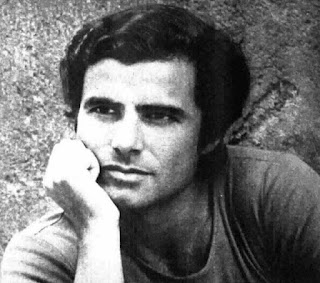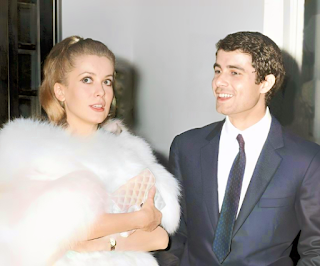Film regarded as director Dino Risi’s masterpiece
 |
| Jean-Louis Trintignant (left) and Vittorio Gassman driving along Via Aurelia in Il sorpasso |
Directed by Dino Risi, produced by Mario Cecchi Gori and with Vittorio Gassman outstanding as one of the film’s male lead characters, made its debut in the United States in December of the following year under the title The Easy Life. It was also a pioneer for the so-called “road movie” in Italy.
It has been judged as such a significant contribution to Italian culture that in 2008, Il sorpasso - 'Overtaking' in Italian - was included in the Italian Ministry of Cultural Heritage's 100 Italian films to be saved, a list of 100 films that "have changed the collective memory of the country between 1942 and 1978."
Its inclusion put it in the company of Bicycle Thieves, La strada, La dolce vita, Divorce Italian Style, Rocco and his Brothers and The Leopard among those movies to have made a lasting mark on the minds of Italian audiences.
Il sorpasso tells the story of two strangers - 36-year-old Bruno, a brash, carefree extrovert played by Gassman, and Roberto, a shy law student - who meet in Rome during a holiday and set off in a flashy Lancia Aurelia sports car on a spontaneous road trip through the city and the countryside of Lazio and Tuscany.
Bruno’s reckless charm and devil-may-care approach to life draws Roberto into a whirlwind of fast cars, flirtations and impulsive adventures, sharply at odds with his own cautious nature.
 |
| A publicity poster for Dino Risi's Il sorpasso, released in 1962 |
As they travel, the film highlights Italy’s booming consumer culture and generational tensions. What begins as a comic journey gradually darkens, culminating in a sudden, tragic accident as Bruno, addicted to il sorpasso - overtaking - inevitably attempts one risky manoeuvre too many.
Dino Risi directed more than 50 films over the course of a career spanning half a century but Il sorpasso is considered to be his greatest work and a cornerstone of commedia all’italiana, a genre that blended traditional comedy with biting satire on the contradictions of contemporary Italian society.
Risi, who collaborated with Ettore Scola and Ruggero Maccari on the screenplay, made Il sorpasso as a critique of Italy’s postwar so-called "economic miracle".
Releasing the movie during a period of rapid modernisation and consumerism, Risi’s aim with its themes was to highlight the emptiness behind material prosperity and the reckless pursuit of pleasure.
The two main characters - the impulsive Bruno and the reserved Roberto, played by the French actor Jean-Louis Trintignant - embody the clashing values of postwar Italy: exuberant modern life versus cautious tradition.
The road trip is seen as a metaphor for self-discovery and societal change, with the title itself chosen to reflect what Risi saw as Italy’s rapid, sometimes reckless overtaking of tradition in pursuit of modernity, its tragic conclusion designed to symbolise the fragility of life and the risks of seeking change with too little pause for reflection.
 |
| Dino Risi directed more than 50 movies in a career spanning half a century |
Bruno’s Lancia Aurelia convertible was not just a car but a metaphor for speed, freedom, and the allure of modern Italy. It represented both the excitement of progress and the dangers of reckless living.
Il sorpasso was at first largely ignored by Italian film critics, yet became a hit with cinemagoers, who made it one of the two highest-grossing Italian-made films in Italy for the year ended June 30, 1963.
Those critics warmed to it in time, however. The country’s National Union of Film Journalists handed Gassman their coveted Nastro d’Argento award for Best Actor and the film is now generally considered an undisputed classic, mentioned in the same breath as the work of directors as revered as Michelangelo Antonioni and Luchino Visconti.
It came to be seen as particularly significant among social commentators who see the years of the “economic miracle” in a rather less positive light. While it was a period that saw prosperity and living standards rise after the bleak aftermath of World War Two, it can also be interpreted as the start of Italy’s transformation from a traditionally agricultural and family-centred society into a shallower, individualistic one driven by consumerism.
Il sorpasso influenced many later directors in their work, among them Martin Scorsese, the brilliant American director of Sicilian descent, who cited Il sorpasso as "the model" for his 1986 hit The Color of Money, which starred Paul Newman and Tom Cruise.
 |
| Parioli is known for its elegant tree-lined streets |
Though born in Milan, Dino Risi lived in Rome, including the last 30 years of his life in an apartment in the Aldrovandi Residence in the Parioli district, one of the Italian capital’s most elegant residential areas, renowned for its leafy boulevards, refined atmosphere and cultural landmarks. Nestled between the Villa Borghese gardens and the curve of the Tiber, Parioli developed in the early 20th century as a haven for Rome’s elite. Its name derives from the Monti Parioli hills, once dotted with pear orchards, now home to stately villas, Art Nouveau palazzi, and spacious apartments. The neighbourhood, favoured by diplomats, professionals and artists, is dotted with chic cafés, gourmet restaurants and tranquil parks such as Villa Ada, one of Rome’s largest green spaces and once the Rome residence of the Italian Royal family. Parioli is also the home of the Galleria Nazionale d’Arte Moderna and the Auditorium Parco della Musica, which hosts major concerts and events. As well as a number of elegant hotels, Parioli has many luxury apartments to rent, which make it popular with well-heeled visitors to the capital.
Parioli, Rome hotels from Hotels.com
 |
| The modern Strada Statale I follows the coastal route of the ancient Via Aurelia |
In Il sorpasso, the road trip embarked upon by Bruno and Roberto largely follows the course of the ancient Via Aurelia, which was originally built in 241BC by consul Gaius Aurelius Cotta, with the aim of connecting Rome with the colonies along the Tyrrhenian coast, ending in Pisa but linking with the Via Aemilia Scaura, which led from Pisa to Genoa. Combined with the Via Appia, which led from Rome to Apulia, it meant the Romans had use of a continuous route from the Ligurian coast in the northwest to the port city of Brindisi in the southeast. The Roman road stretched over 1,000km, with about 700km of the Via Aurelia’s route still in use as a paved road, incorporated into the Strada Statale 1, also known as SS1 Aurelia, which runs from Rome to the French border near Ventimiglia. The adaptation of the ancient road for modern use was helped by the way it was built. The Via Aurelia, like other Roman roads at the time, was paved at a width of approximately 4.6 metres (15 feet), to allow standard size chariots to pass each other comfortably. The Romans, ever inventive, could be said to have been the pioneers of modern service areas in that every 15 miles or so along Via Aurelia, a ‘statio’ would be constructed to provide travellers with food, shelter, stables and a means to buy horses or other travel equipment for their journey.
Search Pisa hotels with Expedia
More reading:
How Dino Risi saw the potential in future stars such as Sophia Loren and Alberto Sordi
Otto e mezzo - the Fellini masterpiece hailed as ‘better’ than La dolce vita
Michelangelo Antonioni - the last great of Italian cinema’s post-war golden era
Also on this day:
343: The death of Saint Nicholas of Bari
1478: The birth of courtier and diplomat Baldassare Castiglione
1586: The birth of astronomer Niccolò Zucchi
1794: The birth of opera star and Royal voice coach Luigi Lablache
1921: The birth of lawyer and composer Piero Piccione
1975: The birth of businessman Andrea Agnelli
_Clara_Calamai_(3).png)






.jpg)





















